-
 Bitcoin
Bitcoin $106,754.6083
1.33% -
 Ethereum
Ethereum $2,625.8249
3.80% -
 Tether USDt
Tether USDt $1.0001
-0.03% -
 XRP
XRP $2.1891
1.67% -
 BNB
BNB $654.5220
0.66% -
 Solana
Solana $156.9428
7.28% -
 USDC
USDC $0.9998
0.00% -
 Dogecoin
Dogecoin $0.1780
1.14% -
 TRON
TRON $0.2706
-0.16% -
 Cardano
Cardano $0.6470
2.77% -
 Hyperliquid
Hyperliquid $44.6467
10.24% -
 Sui
Sui $3.1128
3.86% -
 Bitcoin Cash
Bitcoin Cash $455.7646
3.00% -
 Chainlink
Chainlink $13.6858
4.08% -
 UNUS SED LEO
UNUS SED LEO $9.2682
0.21% -
 Avalanche
Avalanche $19.7433
3.79% -
 Stellar
Stellar $0.2616
1.64% -
 Toncoin
Toncoin $3.0222
2.19% -
 Shiba Inu
Shiba Inu $0.0...01220
1.49% -
 Hedera
Hedera $0.1580
2.75% -
 Litecoin
Litecoin $87.4964
2.29% -
 Polkadot
Polkadot $3.8958
3.05% -
 Ethena USDe
Ethena USDe $1.0000
-0.04% -
 Monero
Monero $317.2263
0.26% -
 Bitget Token
Bitget Token $4.5985
1.68% -
 Dai
Dai $0.9999
0.00% -
 Pepe
Pepe $0.0...01140
2.44% -
 Uniswap
Uniswap $7.6065
5.29% -
 Pi
Pi $0.6042
-2.00% -
 Aave
Aave $289.6343
6.02%
What does it mean that the Bias indicator rebounds quickly above the zero axis?
A quick rebound of the Bias indicator above zero suggests bullish momentum returning, signaling potential entry opportunities for traders.
Jun 15, 2025 at 03:14 pm
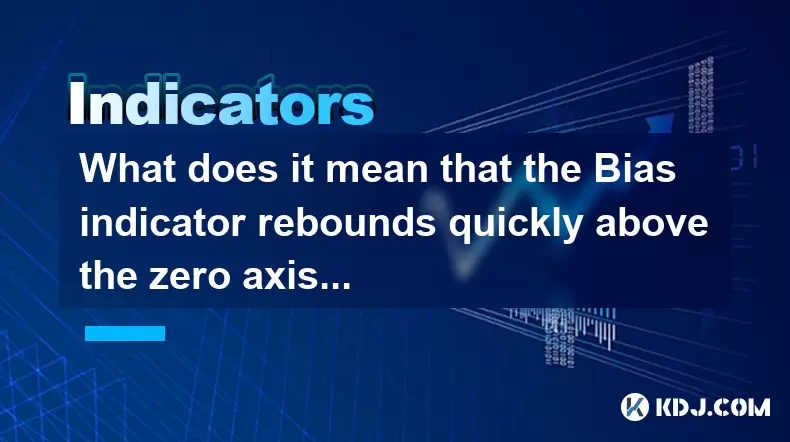
Understanding the Bias Indicator in Cryptocurrency Trading
The Bias indicator, commonly used in technical analysis, measures the deviation of a cryptocurrency's price from its moving average. This deviation helps traders understand whether an asset is overbought or oversold. In the context of cryptocurrency trading, where volatility is high and trends can reverse rapidly, the Bias indicator becomes a crucial tool for gauging market sentiment.
When the Bias indicator rebounds quickly above the zero axis, it suggests that the price has moved back toward the mean after a period of downward deviation. The zero axis represents the point at which the price equals the moving average value. A quick rebound implies a swift return to equilibrium, often signaling strong buying pressure or a potential shift in momentum.
What Happens When the Bias Indicator Crosses Above Zero?
A cross above the zero axis indicates that the current price has surpassed the moving average. This movement can be interpreted as a sign of bullish momentum returning to the market. For instance, if Bitcoin’s price had been trending below its 20-day moving average and then surges upward, crossing the zero line, this may indicate that buyers are regaining control.
- Price recovery: The cryptocurrency is recovering from a short-term downtrend.
- Momentum shift: There is a noticeable shift from bearish to bullish sentiment.
- Potential entry signal: Traders might view this as a favorable time to enter long positions.
In fast-moving crypto markets, such signals need to be corroborated with volume data or other indicators like RSI or MACD to avoid false positives.
Why Is a Quick Rebound Significant in Crypto Markets?
Cryptocurrencies are known for their rapid price swings and sudden trend reversals. A quick rebound of the Bias indicator above the zero axis can highlight the strength and speed of a reversal. This is particularly relevant in assets like Ethereum or altcoins that experience sharp corrections followed by equally aggressive recoveries.
- Market resilience: A rapid bounce shows strong support levels being tested and held.
- FOMO-driven rallies: Sudden inflows due to fear of missing out (FOMO) can push prices back up swiftly.
- Algorithmic trading impact: High-frequency trading bots often trigger quick price adjustments based on moving averages.
Traders who monitor these dynamics closely can benefit from early entries into emerging trends.
How to Interpret This Signal in Different Market Conditions
The interpretation of the Bias indicator rebounding quickly above the zero axis must consider broader market conditions:
- Bull market environment: In a rising market, such a rebound could suggest continuation rather than reversal. It reinforces confidence among holders and may attract new buyers.
- Bear market environment: Here, the rebound might be a temporary relief rally rather than a sustainable uptrend. Caution is advised unless other indicators confirm the move.
- Sideways consolidation: A quick bounce in a range-bound market might indicate strong support zones where demand consistently outweighs supply.
Each scenario demands different risk management strategies and confirmation tools.
Practical Steps to Analyze and Act on This Signal
To effectively utilize the Bias indicator rebounding above the zero axis, follow these practical steps:
- Set up the indicator correctly: Use platforms like TradingView or Binance’s native tools to apply the Bias indicator. Typically, it’s calculated as (Current Price - Moving Average) / Moving Average * 100.
- Choose appropriate timeframes: Short-term traders might use 5-minute or 15-minute charts, while swing traders may rely on daily or weekly charts.
- Overlay with moving averages: Confirm the crossover with the direction of major moving averages (e.g., 50-day or 200-day).
- Check volume spikes: A surge in trading volume during the rebound adds credibility to the signal.
- Use additional oscillators: Cross-reference with RSI or Stochastic to filter out false signals.
- Place stop-loss orders: Protect your position by setting stops just below key support levels identified through candlestick patterns or previous lows.
This step-by-step approach ensures that traders do not act solely on one signal but combine multiple layers of analysis for better decision-making.
Common Misinterpretations and How to Avoid Them
One common mistake is interpreting every rebound above the zero axis as a buy signal. However, in highly volatile crypto markets, this can lead to losses if not confirmed by other metrics. Another error is ignoring divergences between the Bias indicator and actual price action.
- Avoid acting on isolated signals: Always combine with volume, trendlines, or other indicators.
- Watch for divergence: If the Bias indicator moves up but the price doesn’t confirm, it may indicate weakening momentum.
- Don’t ignore macro factors: News events, regulatory updates, or global economic shifts can override technical signals.
By staying alert to these pitfalls, traders can refine their strategy and improve accuracy.
Frequently Asked Questions
Q: Can the Bias indicator be used alone for trading decisions?
While the Bias indicator provides useful insights, relying solely on it can result in misleading signals. Combining it with other technical tools like RSI, MACD, or volume analysis increases reliability.
Q: What is the ideal moving average to pair with the Bias indicator?
There is no universal answer; however, many traders prefer using the 20-period or 50-period simple moving average for short to medium-term trading. Longer-term investors may opt for the 200-period SMA.
Q: Does a quick rebound always indicate a strong trend?
Not necessarily. In some cases, especially during low liquidity or sideways markets, the Bias indicator may show a quick rebound without any real underlying strength. Confirmation from other indicators is essential.
Q: How does the Bias indicator perform across different cryptocurrencies?
Its effectiveness varies depending on the volatility and liquidity of the specific cryptocurrency. Major coins like Bitcoin and Ethereum tend to provide more reliable signals compared to smaller-cap altcoins.
Disclaimer:info@kdj.com
The information provided is not trading advice. kdj.com does not assume any responsibility for any investments made based on the information provided in this article. Cryptocurrencies are highly volatile and it is highly recommended that you invest with caution after thorough research!
If you believe that the content used on this website infringes your copyright, please contact us immediately (info@kdj.com) and we will delete it promptly.
- 2025-W Uncirculated American Gold Eagle and Dr. Vera Rubin Quarter Mark New Products
- 2025-06-13 06:25:13
- Ruvi AI (RVU) Leverages Blockchain and Artificial Intelligence to Disrupt Marketing, Entertainment, and Finance
- 2025-06-13 07:05:12
- H100 Group AB Raises 101 Million SEK (Approximately $10.6 Million) to Bolster Bitcoin Reserves
- 2025-06-13 06:25:13
- Galaxy Digital CEO Mike Novogratz Says Bitcoin Will Replace Gold and Go to $1,000,000
- 2025-06-13 06:45:13
- Trust Wallet Token (TWT) Price Drops 5.7% as RWA Integration Plans Ignite Excitement
- 2025-06-13 06:45:13
- Ethereum (ETH) Is in the Second Phase of a Three-Stage Market Cycle
- 2025-06-13 07:25:13
Related knowledge
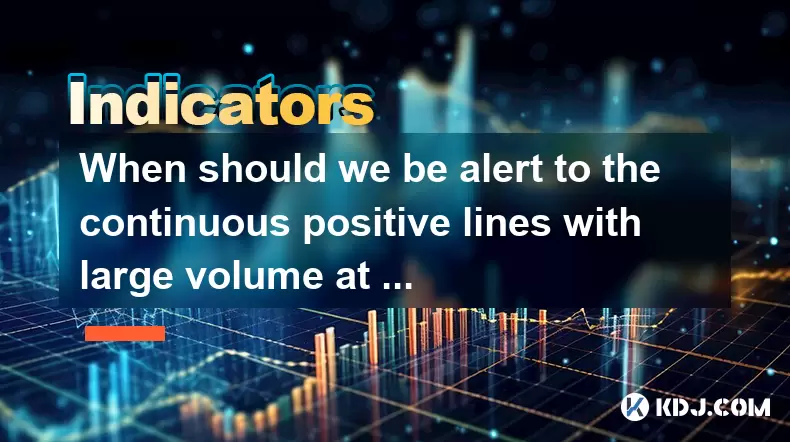
When should we be alert to the continuous positive lines with large volume at low levels?
Jun 16,2025 at 10:56pm
Understanding Continuous Positive Lines in Cryptocurrency ChartsIn the world of cryptocurrency trading, chart patterns are essential tools for predicting price movements. One such pattern that traders often observe is a series of continuous positive lines—also known as bullish candles—appearing at low price levels. These lines, especially when accompani...
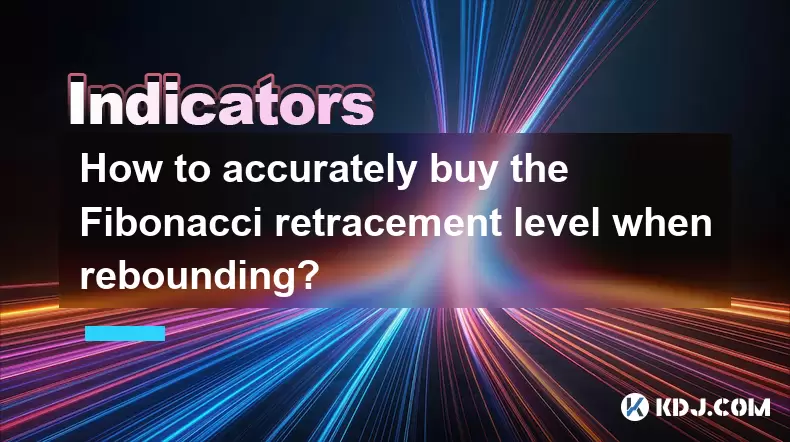
How to accurately buy the Fibonacci retracement level when rebounding?
Jun 16,2025 at 09:56pm
Understanding the Fibonacci Retracement ToolThe Fibonacci retracement is a popular technical analysis tool used by traders to identify potential support and resistance levels. It is based on the idea that markets will retrace a predictable portion of a move before continuing in the original direction. The key Fibonacci levels are typically 23.6%, 38.2%,...

How to set the stop profit point after the high-level propeller pattern?
Jun 16,2025 at 08:04pm
Understanding the High-Level Propeller PatternThe high-level propeller pattern is a technical analysis formation often observed in cryptocurrency trading charts. It typically appears at significant price peaks and signals potential reversals. The pattern consists of a large candlestick with long upper and lower shadows, resembling a propeller, indicatin...

When is the most reasonable stop loss after the three crows pattern?
Jun 16,2025 at 08:14pm
Understanding the Three Crows Pattern in Cryptocurrency TradingThe three crows pattern is a well-known bearish reversal signal in technical analysis, particularly relevant in volatile markets like cryptocurrency. It typically appears at the end of an uptrend and consists of three consecutive long red (or bearish) candles with progressively lower closes....
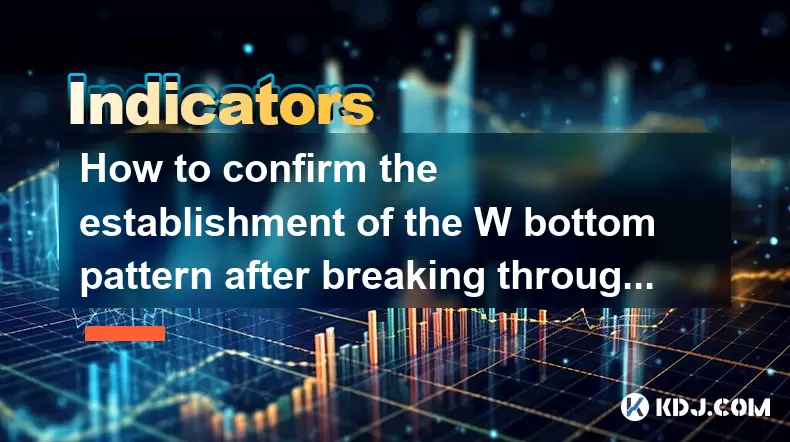
How to confirm the establishment of the W bottom pattern after breaking through the neckline?
Jun 16,2025 at 10:28pm
Understanding the W Bottom Pattern in Cryptocurrency TradingThe W bottom pattern is a popular technical analysis formation used by traders to identify potential reversal points in price trends. It typically appears at the end of a downtrend and signals a possible shift towards an uptrend. The pattern gets its name from its shape, which resembles the let...
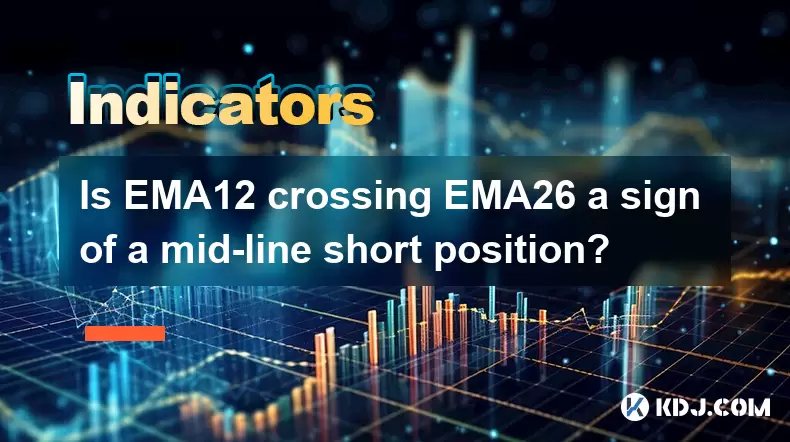
Is EMA12 crossing EMA26 a sign of a mid-line short position?
Jun 16,2025 at 07:22pm
Understanding EMA12 and EMA26 in Cryptocurrency TradingIn the world of cryptocurrency trading, Exponential Moving Averages (EMAs) are widely used tools for analyzing price trends. Specifically, the EMA12 and EMA26 are two of the most commonly referenced EMAs among traders. The EMA12 represents a short-term moving average calculated over the past 12 time...

When should we be alert to the continuous positive lines with large volume at low levels?
Jun 16,2025 at 10:56pm
Understanding Continuous Positive Lines in Cryptocurrency ChartsIn the world of cryptocurrency trading, chart patterns are essential tools for predicting price movements. One such pattern that traders often observe is a series of continuous positive lines—also known as bullish candles—appearing at low price levels. These lines, especially when accompani...

How to accurately buy the Fibonacci retracement level when rebounding?
Jun 16,2025 at 09:56pm
Understanding the Fibonacci Retracement ToolThe Fibonacci retracement is a popular technical analysis tool used by traders to identify potential support and resistance levels. It is based on the idea that markets will retrace a predictable portion of a move before continuing in the original direction. The key Fibonacci levels are typically 23.6%, 38.2%,...

How to set the stop profit point after the high-level propeller pattern?
Jun 16,2025 at 08:04pm
Understanding the High-Level Propeller PatternThe high-level propeller pattern is a technical analysis formation often observed in cryptocurrency trading charts. It typically appears at significant price peaks and signals potential reversals. The pattern consists of a large candlestick with long upper and lower shadows, resembling a propeller, indicatin...

When is the most reasonable stop loss after the three crows pattern?
Jun 16,2025 at 08:14pm
Understanding the Three Crows Pattern in Cryptocurrency TradingThe three crows pattern is a well-known bearish reversal signal in technical analysis, particularly relevant in volatile markets like cryptocurrency. It typically appears at the end of an uptrend and consists of three consecutive long red (or bearish) candles with progressively lower closes....

How to confirm the establishment of the W bottom pattern after breaking through the neckline?
Jun 16,2025 at 10:28pm
Understanding the W Bottom Pattern in Cryptocurrency TradingThe W bottom pattern is a popular technical analysis formation used by traders to identify potential reversal points in price trends. It typically appears at the end of a downtrend and signals a possible shift towards an uptrend. The pattern gets its name from its shape, which resembles the let...

Is EMA12 crossing EMA26 a sign of a mid-line short position?
Jun 16,2025 at 07:22pm
Understanding EMA12 and EMA26 in Cryptocurrency TradingIn the world of cryptocurrency trading, Exponential Moving Averages (EMAs) are widely used tools for analyzing price trends. Specifically, the EMA12 and EMA26 are two of the most commonly referenced EMAs among traders. The EMA12 represents a short-term moving average calculated over the past 12 time...
See all articles

























































































